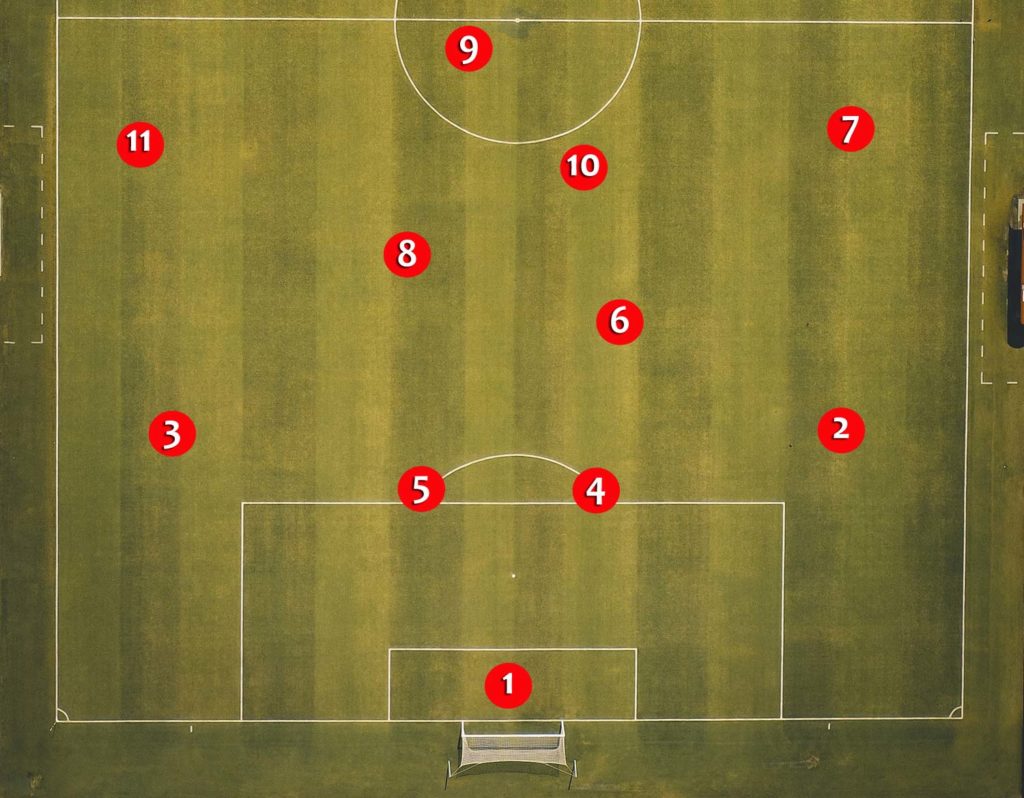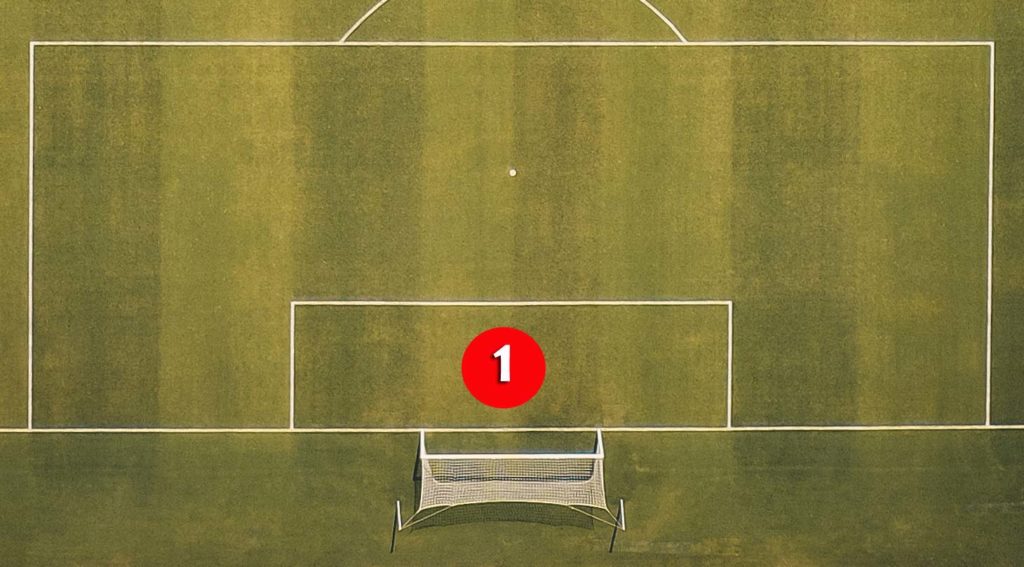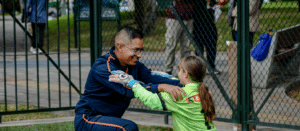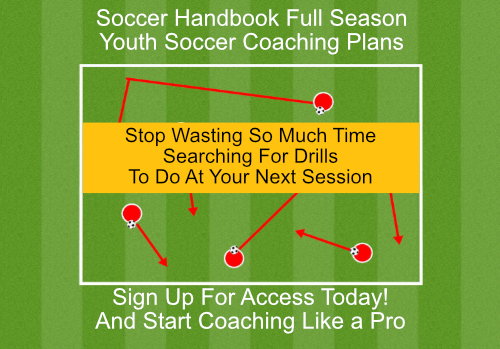The Positions in Soccer Explained, Their Numbers, and Roles
Learning the details between the different positions in soccer can be a challenge with the pace of play, set pieces, and rules that sometimes feel up to a referee’s personal interpretation.
Soccer Handbook has taken the time to break down the fundamentals of each of the positions in soccer, their roles, as well as some of the philosophies behind these positions.
Soccer Positions
- Forward (Center forward, Striker, Winger)
- Midfielder (Center midfield, Center attacking midfield, Defensive midfield, Wing midfield)
- Defender (Center-back, Sweeper, Full-back, Wing-back, Stopper. Outside-back)
- Goalkeeper (Keeper)
Need help with youth soccer formations? Check out our article: Youth Soccer Positions and Their Roles.
The Tradition of Number Positions in Soccer
The earliest recorded use of jersey numbers in English league play was in 1928.
It wouldn’t be until eleven years later, in 1939, that soccer jersey numbers were made mandatory (for both teams) by a vote of 24 in favor and 20 opposed by the league’s governing board. Both teams would have their starting line-ups in numbers one through eleven, with each number representative of that player’s position.
Stop wasting time Googling drills for your next practice.
Sign up for our Full Season Coaching Plans!
Soccer Positions By Number
- 1 – Goalkeeper (GK)
- 2 – Right Fullback (RB)
- 3 – Left Fullback (LB)
- 4 – Center Back (CB)
- 5 – Center Back (CB)
- 6 – Defending/Holding Midfielder (CDM)
- 7 – Right Midfielder/Winger (RM/LW)
- 8 – Central/Box-to-Box Midfielder (CM)
- 9 – Striker (S)
- 10 – Attacking Midfielder/Playmaker (CAM)
- 11 – Left Midfielder/Wingers (LM/LW)

We’ll go into each of these positions more in-depth, but before we do, the last thing to note is that numbers in soccer are transferable. In other words, no single player has ownership of a number.
For example, Robert Lewandowski wears #9 for Bayern Munich as well as when playing for the Polish national team. But if he is out of the lineup due to injury for either team, another teammate can wear the #9.
The modern game is changing, with some players choosing more unique numbers like Liverpool’s Trent Alexander-Arnold sticking with his original #66 from his academy days, but the traditional numbering system still holds up across most teams and leagues globally.
Basic Positions in Soccer
Any roster of soccer players from the youngest leagues to the most professional can be sectioned into three main categories: Forwards, Midfielders, and Defenders. For simplicity, we include Goalkeepers in “defenders,” but we’ll outline what makes keepers so special later.
These three categories provide guidelines on where these players will stand and move into formation on the field, but it’s important to note these labels are not restrictions. In fact, part of what makes soccer a great sport for everyone involved is how positions rely on specialization instead of restriction.
Soccer Positions Emphasize Specialization
What puts soccer on a level above other professional and recreational sports is that the rules don’t try to limit the abilities of specific positions.
For example, if you were to play American Football, only one person per play can be the quarterback. Only that person is allowed to line up, start the play, and potentially throw it downfield for a touchdown.
In soccer, every player has the opportunity to be “the quarterback” whenever the ball is at their feet. Whether you’re a forward, midfielder, defense, or even a goalkeeper, you can deliver that perfect cross or through ball and assist your teammate with a goal.
This means that players are sorted into their positions based on their specific skill sets, like shooting, passing, dribbling, and tackling, rather than more arbitrary measures like their height, strength, or weight. A well-rounded skill set as a player will lead to more playing opportunities and grow your knowledge of the game.
Position: Forwards

Some of the most recognizable players are forwards because forwards make up the field positions in soccer that are typically responsible for the most goals on a team.
9 – Striker (S):
The striker is usually the player positioned closest to the other team’s goal, and their primary role is to score goals. Strikers are responsible for making their own scoring chances and making the most of the chances their forward teammates, like wingers or second strikers, present to them. Plus, a great forward just knows where to be at the right time.
7/11 – Winger (LW, RW):
While Wingers fluctuate between the forward and midfielder zones, their role is to help spread the defense thin by pushing the ball out wide and then passing to a teammate or dribbling into the box. Wingers need confidence in their one-on-one skills as well as the stamina to push the pace and capitalize on a defender’s mistake.
10 – Attacking Midfielder (AM):
Also referred to as the second striker position, players in the #10 position are first and foremost playmakers. They force the defense to respect their scoring ability whenever the ball is at their feet, and they facilitate the offense around them.
While soccer forwards are not expected to be the best at tackles and winning possession, a forward that takes the time to develop a high work rate can pressure defenders into making mistakes and open up even more opportunities to score.
Position: Midfielders

A common phrase that you’ll hear for soccer midfielders is box-to-box. This is a pretty good indication of where midfielders will spend most of their time on the field as well.
If you’ve ever wondered, “What are the positions in soccer that do the most running?” The answer is the midfield. Great midfielders need skills on the offensive and defensive side of the ball as well as the stamina to run “box to box.” Their role requires them to ensure the ball moves smoothly from one end of the field to the other.
8 – Central Midfielder (CM):
Also, sometimes thought of as “the engine,” players in the central midfield role have to be some of the hardest-working players on the team. Central midfielders will see the most action in any game on either side of the ball. While central midfielders can take long shots if left open, their primary responsibility is to distribute the ball safely from defenders to their forwards.
6 – Defensive Midfielder (DM):
Also known as a holding midfielder, a defensive midfielder plays directly in front of the center backs and acts as the last line of defense for the midfield. Defensive midfielders are expected to keep the ball from reaching their defense and quickly distribute it back toward their offense.
7/11 – Winger (LW, RW):
As we said earlier, wingers move freely between offensive and midfield zones, but if wingers are positioning themselves behind the line of forwards, they may be considered midfielders.
Their role doesn’t fundamentally change, though they may be expected to play a more significant role from moving the ball from the defense through to the offense. In the modern game, wingers also work as partners, often switching from the left to the right side. This creates confusion for the opposing team’s defense.
Many goals start with successful play during the build-up in the midfield. Midfielders have the opportunity to start plays or develop their own long-shot skills and create plays of their own.
Position: Defenders

The biggest myth about defensive positions in soccer is that soccer defenders don’t get the chance to score. It’s not true! Defenders are used in a variety of ways on offense.
If a defender is taller or skilled at headers, the coach may have them play up on corner kicks as an aerial threat. Soccer games average 9-10 corner kicks per game split between the two teams. That means that if you develop aerial scoring ability, you could expect at least three good scoring opportunities per game just using your head!
4/5 – Center Back (CB):
Center backs represent the anchors of your defense line and sometimes even hold the title of team captain.
These players hold down the middle of the defensive line and disrupt some of the best shooting angles for the opposing team. A center-back needs to be confident in their ability to step in and make a tackle when it counts.
Most modern teams play with two Center Backs that work in tandem. When one steps forward, the other drops back. More traditionally, teams used a Sweeper and a Stopper where the two players were more vertically aligned. The Stopper played in a more advanced position, and the sweeper was the last field player before the Goalie.
3/2 – Fullback (LB, RB):
These two defenders play on the left and right sides of the defensive line and are often referred to as the left-back and right-back. Their primary role is to protect their side, as well as assist the two center backs.
These defensive backs move further up the field than center backs and may even be responsible for the first pass in an offensive play. Players like Philipp Lahm, Andrew Robertson, and Alphonso Davies have revolutionalized the Outside Back position. These players cover the sidelines from almost endline to endline creating chances with crosses into the box and putting a stop to their opponent’s attacks in their own end.
1 – Goalkeeper (GK):
By far the most unique position on the field. Goalkeepers represent the last line of defense for a team. Goalkeepers are the only players who can use their arms and hands, and they can only do so within their own penalty area. Outside of their penalty area, they have to play like any other position. While it’s true goalkeepers have the least opportunity to score out of any other position, there are still times when they do.

Remember, Every Soccer Player Does Everything
The biggest thing to remember is that every position plays offense and defense on a soccer pitch.
While it’s nice to be exceptional at one skill like shooting, a striker that can only shoot and can’t dribble, pass the ball, or play the ball back isn’t worth all that much to the team.
Players need a well-rounded skill set on offense and defense, no matter what position they want to play. Encourage them to jump in for playing time in any position that needs a substitute.
If players focus on developing those skill sets, learning more positions, and seeing the game from different points of the field, their knowledge of the game will only increase.
Ultimately, it will make your athletes better soccer players in the short term and long term.






